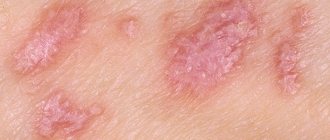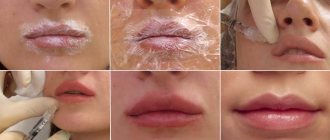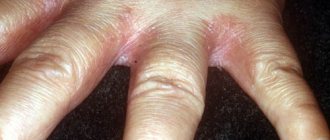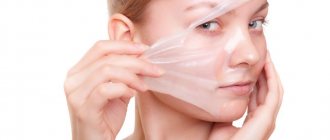Face and body peeling is a favorite procedure for many women, which helps the skin renew itself and look healthy. But cosmetologists do not recommend peeling during pregnancy. In any case, by those aggressive methods to which everyone is accustomed.
How to be? There is no need to completely give up cleansing your skin. Peeling during pregnancy should be gentle. You can use natural cosmetics, soft abrasive materials, and perform ultrasonic cleaning of pores. But it is better to leave deep chemical peeling until lactation ends.
What are the contraindications?
The procedure is a type of aggressive effect on the epidermis, so it is not allowed for everyone. Contraindications include:
- stage of exacerbation of infectious, viral, bacterial, fungal processes on the skin;
- unhealed wounds, cuts, abrasions, scratches;
- tendency to form keloid scars;
- tanning 2 weeks or less old;
- chronic diseases in the relapse stage;
- oncological pathologies;
- intolerance to the components of peeling preparations;
- pregnancy and lactation;
- recent laser procedures;
- large moles;
- unstable mental state.
The procedure is not performed if the patient is not feeling well: with fever, pain, high blood pressure, colds, or other ailments.
Acne vulgaris is a chronic inflammatory disease of the pilosebaceous unit and is characterized by non-inflammatory (comedones) and inflammatory lesions (papules, pustules and nodules) that can lead to scar formation and psychological stress. In women who are planning a pregnancy or who are pregnant, this condition can be especially bothersome given the physiological changes as well as the unpredictable nature of acne during this time. Acne often improves during the first trimester, but can worsen during the third trimester due to increased androgen levels and increased sebum production. In addition to hormonal changes, immunological changes may also contribute during pregnancy. Inflammatory lesions tend to be more widespread than noninflammatory lesions, often extending to the trunk. Patients with a history of acne are more likely to develop acne during pregnancy. Treating acne during pregnancy can be challenging, as many commonly used and effective treatment options are contraindicated or not recommended. Therefore, it is important for the physician prescribing therapy for a pregnant woman to be familiar with the treatment restrictions adopted by the US Food and Drug Agency (FDA) (Table 1). Due to the inherent ethical issues associated with the impossibility of clinical trials during pregnancy, pharmacokinetic and pharmacodynamic data to evaluate drug safety during pregnancy are limited, and randomized controlled trials of acne medications do not exist. Thus, most treatment recommendations are based on observational and animal studies. Here we review the data on the safety and effectiveness of common medications for acne and outline a practical approach to treating acne during pregnancy based on the latest available evidence (Table 2). Armed with this information, physicians can develop a safe and effective acne treatment regimen for this unique patient population.
Table 1. Pregnancy Risk Categories (FDA)
| Category A | Adequate, well-controlled studies in pregnant women have not shown an increased risk of fetal abnormalities. |
| Category B | Animal studies have shown no evidence of harm to the fetus; However, there are no adequate and well-controlled studies in pregnant women. |
| or | |
| Animal studies have shown negative effects, but adequate and well-controlled studies in pregnant women have failed to demonstrate a risk to the fetus. | |
| Category C | Animal studies have shown negative effects and there are no adequate and well-controlled studies in pregnant women. |
| or | |
| No animal studies have been conducted and there are no adequate and well-controlled studies in pregnant women. | |
| Category D | Adequate well-controlled or observational studies in pregnant women suggest a risk to the fetus. However, the benefits of therapy may outweigh the potential risks. |
| Category X | Adequate well-controlled or observational studies in animals or pregnant women have demonstrated positive evidence of fetal abnormalities. Use of the drug in women who are or may become pregnant is contraindicated. |
| Undefined category | Drugs not classified by the FDA for use in pregnancy |
Table 2. Algorithm for treating acne during pregnancy
| Acne type | Treatment | Pregnancy drug class (FDA) | Rating data |
| Non-inflammatory | |||
| Comedones | Azelaic acid | IN | Probably might be useful |
| Inflammatory | |||
| Mild to moderate severity | Azelaic acid + | IN | Probably to be useful |
| Benzoyl peroxide or | WITH | Profitable | |
| Topical erythromycin or | IN | Profitable | |
| Topical clindamycin + | IN | Profitable | |
| Benzoyl peroxide | WITH | Profitable | |
| Moderate to severe | Oral erythromycin or | IN | Probably might be useful |
| Oral cephalexin + | IN | * | |
| Benzoyl peroxide with or without | WITH | Profitable | |
| Azelaic acid or | IN | Probably might be useful | |
| Intralesional steroid injections | WITH | * | |
| Lightning (Fulminant) | Oral erythromycin + | IN | Probably might be useful |
| Benzyl peroxide + | WITH | Profitable | |
| Azelaic acid + | IN | Probably might be useful | |
| Oral prednisolone (short-term) | WITH | * |
Literature search and data sources
For this review, PubMed was searched using the following key terms: acne, pregnancy, azelaic acid, benzoyl peroxide, salicylic acid, aminolevulinic acid, photodynamic therapy, FDA pregnancy. No publication date restrictions were applied. The search included meta-analyses of randomized controlled trials, clinical trials and reviews. In addition, the search was conducted in the EMBASE, Cochrane and UpToDate databases.
Local treatment
For mild to moderate acne, topical therapy is the standard of care. It is also an important component of treatment for more severe acne and acts synergistically with oral agents. During pregnancy, the degree of systemic absorption of the topical anti-acne drug should be taken into account. The properties of commonly used topical agents are summarized in the following sections and Table 3.
Table 3. Selected topical medications for acne in pregnant women
| A drug | FDA category | Mechanism of action | Release form | Notes |
| Azelaic acid | IN | antimicrobial comedolytic anti-inflammatory antityrosinous activity | Cream (20%; approved for acne) Gel (15%; approved for rosacea) | Monotherapy possible Bacterial resistance not established May improve post-inflammatory hyperpigmentation |
| Benzoyl peroxide | WITH | antibacterial comedolytic anti-inflammatory | shampoo, gel, foam, lotion, cream (2.5-10%) | Monotherapy possible Bacterial resistance not known May cause discoloration |
| Salicylic acid | WITH | comedolytic keratolytic | lotion, cleanser, gel, cream, foam, soap, toner (0.5-6%) | Tolerability is generally good Inferior to azelaic acid and benzoyl peroxide in effectiveness |
| Erythromycin | IN | antibacterial | gel, solution, ointment (2%) erythromycin / benzoyl peroxide gel (3% / 5%) | Should not be used as monotherapy Bacterial resistance is reduced when combined with benzoyl peroxide |
| Clindamycin | IN | antibacterial | gel, lotion, solution, foam, tampon (1%) clindamycin / benzoyl peroxide gel (1% / 5%, 1.2% / 2.5%) | Should not be used as monotherapy Use with caution in patients with a history of gastrointestinal disease Bacterial resistance is reduced when combined with benzoyl peroxide |
| Tazarotene | X | comedolytic anti-inflammatory | cream, gel, foam (0.05% / 0.1%) | Contraindicated during pregnancy |
| Tretinoin | WITH | comedolytic anti-inflammatory | gel (0.01% / 0.025% / 0.05%), microspheres gel (0.04% / 0.08% / 0.1%), cream (0.02-0.1%) | Not recommended during pregnancy |
| Adapolene | WITH | comedolytic anti-inflammatory | lotion, cream (0.1%) gel (0.1% / 0.3%) adapalene / benzoyl peroxide gel (0.1% / 2.5%) | Not recommended during pregnancy |
| Dapsone | WITH | anti-inflammatory antimicrobial | gel (5%) | Low risk of maternal anemia, neonatal hyperbilirubinemia and hemolytic anemia in patients with glucose-6-phosphate dehydrogenase deficiency (for topical dapsone) |
Azelaic acid
Azelaic acid is classified as pregnancy category B because animal studies have not shown a teratogenic effect and there are no data from human studies. Azelaic acid is a natural dicarboxylic acid with antimicrobial, comedolytic and mild anti-inflammatory properties with the added benefit of reducing post-inflammatory hyperpigmentation. There was no evidence of resistance to azelaic acid in P. acnes. After applying it to the skin, approximately 4% of the drug enters the bloodstream.
Benzoyl peroxide
Benzoyl peroxide is classified as pregnancy category C. Approximately 5% enters the bloodstream and is completely metabolized into benzoic acid, which is also known as a dietary supplement. Due to rapid renal clearance, no systemic toxicity is expected, and the risk of congenital malformations is theoretically low. Benzoyl peroxide has antimicrobial, comedolytic and anti-inflammatory properties. To date, the fact of resistance of P. acnes to benzoyl peroxide has not been established. Benzoyl peroxide is considered safe during pregnancy and helps prevent the development of resistance when used in combination with antibiotics.
Salicylic acid
Salicylic acid is classified as pregnancy category C. There are no studies on the topical use of salicylic acid in humans during pregnancy, although malformations have been described in rat embryos with systemic exposure to salicylic acid and aspirin administration during pregnancy. This is a keratolytic agent. Widespread use of high concentrations of salicylic acid for hyperkeratoses of the skin has resulted in cases of salicylate toxicity, but there are no similar known cases associated with the use of drugs containing it for acne. The risk during pregnancy is low when used on limited areas of the skin for short periods.
Topical antibiotics
Topical antibiotics have long been used to treat inflammatory acne; Erythromycin and clindamycin are the two most commonly prescribed antibiotics for acne in pregnancy. Both are classified as pregnancy category B. Short-term use of topical erythromycin and clindamycin during pregnancy is safe. However, no studies have been conducted on the effects of their long-term use. Given case reports of membranous colitis caused by Clostridia, topical clindamycin should be used with caution in patients with a history of gastrointestinal disease. Topical clindamycin and erythromycin reduce the number of P. acnes in sebaceous follicles by inhibiting bacterial protein synthesis, thereby suppressing inflammatory acne. The combined use of topical antibiotics with benzoyl peroxide reduces the development of bacterial resistance and increases the effectiveness of treatment.
Topical retinoids
Topical retinoids are derivatives of vitamin A and have been used to treat acne for over 30 years. In the United States, these include adapalene, tretinoin, and tazarotene. Adapalene and tretinoin are classified as pregnancy Category C drugs by the FDA, while tazarotene is classified as Category X. This is partly due to the high incidence of birth defects associated with the use of the systemic retinoid isotretinoin. Therefore, tazarotene is not recommended for use during pregnancy. Despite reports of possible birth defects, topical adapalene and tretinoin are unlikely to cause birth defects given their poor cutaneous resorption. A recent meta-analysis excluded the possibility of a significant increase in the incidence of miscarriages, congenital malformations, prematurity and low birth weight. Mechanisms of action include acceleration of keratinocyte differentiation, comedolytic and anti-inflammatory effects. These drugs, however, are not recommended for pregnant women, because their risk-benefit ratio remains questionable.
Topical Dapsone
Topical dapsone is a synthetic sulfone with antimicrobial and anti-inflammatory properties. It is classified as category C in pregnancy. High doses in animals have not shown teratogenic effects. To date, its use during pregnancy has not been associated with an increased risk of fetal defects. The risk of maternal anemia, as well as hyperbilirubinemia and hemolytic anemia in the newborn, is observed with oral dapsone in patients with glucose-6-phosphate dehydrogenase deficiency, but the risk is low with topical dapsone. Topical dapsone was approved for the treatment of acne in 2005. Caution should be exercised given its relatively recent introduction to the market and the lack of controlled studies evaluating its safety during human pregnancy. It should be prescribed during pregnancy only when the benefits clearly outweigh the risks.
Oral medications
Some patients cannot achieve satisfactory results using topical treatments alone. Oral medications are primarily indicated for patients with moderate to severe forms of inflammatory acne and in cases of ineffective topical therapy. The properties of commonly used oral medications are described in the following sections as well as in Table 4.
Table 4. Selected oral antibiotics for acne in pregnant women
| Antibiotic | Pregnancy Categories (FDA) | Dosage | Notes |
| erythromycin | IN | 250-500 mg, 2-4 times / day | Long-term use during pregnancy has not been studied Bacterial resistance is reduced when combined with topical benzoyl peroxide Hepatotoxicity has been associated with erythromycin estolate; Not recommended for pregnancy |
| Azithromycin | IN | Dosage may vary, e.g. 250 mg 3 times/week | More flexible dosing regimen for sensitive patients |
| Cephalexin | IN | 500 mg 2 times a day | Possible staphylococcal resistance |
| Amoxicillin | IN | 250-500 mg 2 times a day | Use in early pregnancy may increase risk of cleft palate |
| Trimethoprim/sulfamethoxazole | WITH | 160/800 mg 2 times a day | Use in the first trimester of pregnancy is associated with miscarriage |
| Tetracycline | D | 250-500 mg 2 times a day | Toxic effects on fetal teeth and bones Avoid during pregnancy |
| Minocycline or doxycycline | D | 50-100 mg | Toxic effects on fetal teeth and bones |
| 1-2 times a day | Should be avoided during pregnancy |
Oral antibiotics
Oral antibiotics improve inflammatory acne by inhibiting the growth of P. acnes in the pilosebaceous complex. Tetracycline antibiotics (including doxycycline and minocycline), in addition to antibacterial, have a direct anti-inflammatory effect. The antibiotics most commonly used by patients (other than pregnant women) are doxycycline, minocycline, erythromycin, azithromycin, cephalexin, and trimethoprim-sulfamethoxazole. Because of increased bacterial resistance, it is generally recommended to combine topical benzoyl peroxide with oral antibiotics, limit the use of short courses of oral antibiotics, and not use oral antibiotics for maintenance treatment of acne. To limit the development of bacterial resistance, changes in oral antibiotics should also be avoided whenever possible; if an oral antibiotic has proven effective in the past, it should be prescribed again. Oral antibiotics should be prescribed during pregnancy only when the need has been clearly established.
Erythromycin is a macrolide classified as category B during pregnancy. The drug does not penetrate the placenta well, resulting in low concentrations in fetal tissues. Erythromycin is generally considered safe during any stage of pregnancy when administered over several weeks. It can be considered the antibiotic of choice for the treatment of severe inflammatory acne in pregnant women. However, its effects have not been studied with long-term use (more than 6 weeks). It should be noted that erythromycin estolate is contraindicated due to maternal hepatotoxicity.
Azithromycin is another macrolide classified as pregnancy category B by the FDA. Animal studies have shown that azithromycin crosses the placenta without causing adverse effects in the fetus. Azithromycin is considered acceptable in pregnant women with acne, but has less available safety data than erythromycin.
The FDA has included amoxicillin in pregnancy category B. Its use in early pregnancy may increase the risk of cleft palate. Amoxicillin can be used alone or in combination with other drugs as the drug of choice for the treatment of refractory acne. May cause gastrointestinal side effects such as nausea and vomiting.
Cephalexin is a first-generation cephalosporin with anti-inflammatory properties and is classified as a category B drug for pregnancy. Cephalexin has not been associated with embryonic defects in animal studies. Although it is effective as an anti-acne drug, there is some concern about the development of staphylococcal resistance to it.
Trimethoprim acts as a folate antagonist and is classified as a pregnancy category C drug. A recent study found that use of trimethoprim in the first trimester was associated with a doubled risk of miscarriage. Therefore, the use of trimethoprim-sulfamethoxazole is recommended for use during pregnancy only when there is no alternative and when the benefits outweigh the risks.
Tetracyclines are classified as Category D drugs in pregnancy. Animal studies have found evidence of fetal and fetotoxicity, including toxic effects to fetal teeth and bones. Tetracyclines bind to calcium orthophosphate and are therefore actively deposited in teeth and bones. Deposits of the drug in the teeth persist for a long time, as a result of which the baby teeth of children exposed to the drug after the 20th week of pregnancy become yellow and darken over time. Deposition in bones leads to reversible retardation of fetal growth and suppression of fibula growth, especially with long-term use of the drug. Tetracyclines should be avoided during pregnancy, especially after the first trimester.
It is important to note that more evidence is needed regarding the recommended duration of these treatments. The effects of long-term use of these antibiotics on the fetus are not known. These considerations must be weighed against the severity of the acne and alternative topical treatments. The use of systemic antibiotics should be limited in the second and third trimesters, after completion of organogenesis, with the duration of therapy limited to 4-6 weeks.
Oral corticosteroids
The severity of severe acne that is resistant to antibiotic therapy can be significantly reduced with the use of oral corticosteroids. Prednisone is classified as pregnancy category C by the FDA. The drug has been associated with cleft palate, slowed brain growth, decreased myelination, and decreased head circumference in animal studies. In humans, studies have shown an increased risk of cleft palate and a slight increase in miscarriage and preterm birth. There is little data on the ability of systemic and topical steroids to cross the placental barrier, although topical steroids have been shown to have systemic effects. Prednisolone may be used for severe or fulminant cases of acne after the first trimester. The use of steroids in the form of small numbers of injections and short courses of oral steroids needed for rare, fulminant cases of acne vulgaris is unlikely to pose additional risks to the fetus. The dosage of prednisolone should be no more than 20 mg/day. and no longer than 1 month during the third trimester.
Oral retinoids
Isotretinoin is often prescribed to patients (other than pregnant women) with persistent, conglobate acne vulgaris. The teratogenic effects of isotretinoin are well known and it is classified as category X. The drug causes characteristic deformities associated with the craniofacial region, central nervous system, cardiovascular system, thymus and parathyroid glands. Isotretinoin was approved in 1982 and works by reducing sebum production and normalizing keratinization processes. Isotretinoin is absolutely contraindicated during pregnancy.
Zinc
Zinc provides another option for pregnant acne patients. Zinc sulfate is considered a pregnancy category C drug, while zinc gluconate has not been officially classified. Animal studies and human studies including pregnant women treated for acne have shown no increased risk of fetal abnormalities or risk of fetal harm at doses less than 75 mg/day. Zinc has antibacterial, anti-inflammatory and sebum-reducing effects. Its effectiveness has been established for mild and moderate inflammatory acne when used alone or in combination with other drugs. The recommended amount of zinc during pregnancy is 11 mg/day. Potential side effects include nausea and vomiting, usually dose-related.
Complementary therapy
Glycolic acid
Glycolic acid is classified as pregnancy category N, that is, it is not classified and is used externally for acne. There are no published reports of any adverse effects during pregnancy. Studies have shown improvement in inflammatory acne and comedones, although closed comedones may be slower to respond. It also has the additional benefits of improving post-inflammatory changes and increasing skin absorption of topical medications.
Photodynamic therapy
Photodynamic therapy is classified as category C. There are no reproductive studies in animals. Compared with control treatment, photodynamic therapy resulted in a statistically significant improvement in acne severity, as well as sustained results up to 20 weeks' gestation after multiple treatments. Lack of insurance coverage and the frequency of required sessions at a dermatologist's office may be a barrier to use in pregnant women.
conclusions
In this review, we have highlighted numerous options for clinicians who treat pregnant patients with acne. We offer the following simplified approach as a starting point for clinicians when working with pregnant patients. For mild acne, characterized primarily by non-inflammatory elements of the rash, topical azelaic acid or benzoyl peroxide may be recommended as basic therapy. For inflammatory acne, it is recommended to begin therapy with a combination of topical erythromycin or clindamycin with benzoyl peroxide. For moderate to severe inflammatory acne, oral erythromycin or cephalexin can be prescribed, which are safe when used for only a few weeks. A course of prednisone for no more than a month may be useful for the treatment of fulminant conglobate cystic acne after the first trimester. In general, topical and oral antibiotics should not be used as monotherapy and should be combined with topical benzoyl peroxide to reduce bacterial resistance. The adjunctive therapies discussed in this review should be considered based on patient response and preference. Key recommendations are summarized in Table 5. We hope that this review will be useful for clinicians treating acne in pregnant women.
Table 5. Basic recommendations for acne during pregnancy
| Clinical Recommendation | Level of evidence | Recommendations |
| Topical azelaic acid (15% or 20%) and benzoyl peroxide (2.5-5%) are effective starting agents. | IN | 36 , 37 |
| Topical erythromycin in combination with benzoyl peroxide (5% maximum) can be used as an alternative for the treatment of inflammatory acne. | WITH | 36 |
| Topical clindamycin in combination with benzoyl peroxide can be used as an alternative to treat inflammatory acne. | WITH | 37 |
| Topical Dapsone is a newer anti-acne agent with less available safety data and should be used with caution in pregnant women. | WITH | 18 |
| Topical and oral antibiotics (eg, erythromycin) should be used in combination with benzoyl peroxide to reduce the risk of bacterial resistance. | WITH | 11 |
| Oral cephalexin can be used for moderate to severe inflammatory acne. | WITH | 25 |
| Intralesional steroid injections can be used to treat moderate to severe inflammatory acne. | WITH | 33 |
| Oral glucocorticoids can be used in short courses to treat fulminant acne after the first trimester. | WITH | 36 |
How does acid affect the skin?
To obtain the effect of acid peeling, different components are used, depending on the patient’s age, the condition of his skin, the depth and volume of defects. Each acid has its own mechanisms of action:
- Almond – gently penetrates into tissues, capable of breaking down fats. Reduces the appearance of defects, fights free radicals, and has antibacterial properties. Used to treat post-acne and acne scars. Mostly suitable for superficial peeling.
- Milk – optimal moisturizing and whitening. Restores skin turgor and elasticity, removes inflammation, reduces the depth of wrinkles.
- Retinoic – promotes collagen synthesis in the body, removes pigmentation. Smoothes out fine wrinkles and improves skin texture.
- Malic acid is a universal acid used to moisturize and saturate cells with oxygen and nutrients. Stimulates microcirculation.
- Glycolic – care for oily skin. Helps with scars, scars, post-acne, eliminates signs of age-related aging. Evens out the texture and tightens pores.
- Ferulic – helps eliminate the effects of ultraviolet exposure. Gently penetrates the dermis, inhibits the inflammatory process, and prevents redness.
- Salicylic acid – dissolves dead epidermal cells, provides deep cleaning of pores. Normalizes the functioning of the sebaceous glands, activates the production of collagen and elastin.
The type of composition for acid peeling, concentration, and exposure time are determined individually by the cosmetologist, depending on the condition of the skin and the age of the patient.
There are three main types of peeling:
- superficial – shallow effect on the epidermis (fruit, glycolic, almond, retinoic, milk);
- median – affects the dermis (salicylic acid, trichloroacetic acid, azelaic acid);
- deep - affects all layers of the skin, down to connective tissue and fiber (phenolic).
Penetrating into the epidermis, the acid burns damaged, old and keratinized tissue, while simultaneously stimulating high activity of regeneration, cell division and the appearance of new structures. Also, chemical exfoliation of the stratum corneum promotes the accelerated production of your own collagen and elastin.
Important! A deep type of cleansing effect is carried out exclusively in special clinic conditions by a cosmetologist. The use of anesthesia and monitoring of the patient's health condition is required.
Advantages of this procedure
Acid peeling has many advantages:
- effective at any age, provided the correct composition is selected;
- stimulates cell renewal, promotes rejuvenation;
- activates tissue regeneration;
- helps reduce the depth of scars and cicatrices;
- effective in the treatment of acne, acne, comedones;
- restores the structure and oval of the face;
- removes hyperpigmentation, freckles, age spots;
- normalizes a healthy complexion;
- promotes collagen production, thereby increasing skin elasticity and firmness;
- inhibits fading processes;
- reduces the depth of wrinkles, fights sagging;
- reduces pores, normalizes sebum production;
- controls water balance;
- provides full access of oxygen and nutrients to cells;
- stimulates blood circulation and microcirculation;
- restores velvety and smoothness of the skin.
Chemical exfoliation is one of the effective ways to rejuvenate and heal the skin. The technique provides the fastest possible results; it is an excellent alternative to surgical interventions and plastic surgery.
Disadvantages of this procedure
Since exposure to acids on the skin is an aggressive process, this technique has disadvantages:
- a large list of contraindications;
- painful sensations due to chemical burns of the skin;
- long rehabilitation period - for superficial and medium penetration of acids is 10 - 14 days, for deep penetration - up to 2 months;
- possible appearance of hyper- or hypopigmentation - dark or light areas on the skin;
- Usually one procedure is not enough - treatment and rejuvenation must be carried out over a course;
- acids can cause allergies, even if there were no complaints of a reaction before the procedure.
After the session, you should not sunbathe for a long time under the sun or in a solarium, since ultraviolet radiation can cause complications. Therefore, acid exfoliation is not recommended in the summer; it is better in the cold season.
Advantages of pregnancy management in our clinic
The Department of Gynecology and Obstetrics of the Pirogov Clinic on Vasilievsky Island (St. Petersburg) is among the TOP 3 best in the city according to the results of the VIII and IX ranking of private clinics (2018-2019). You can view reviews about pregnancy management on our website, as well as on independent platforms. By contacting us, you can be sure of high diagnostic standards and professionalism of doctors. We offer our patients:
- Services of experienced, attentive and caring obstetricians-gynecologists - our specialists worked and improved their skills in clinics in Finland, France, the USA, as well as in maternity hospitals in St. Petersburg.
- Having your own laboratory and all specialized doctors in one place, as well as medical offices equipped with new generation equipment. You can undergo all examinations in a comfortable environment and without queues. We guarantee the reliability of the results. There is no need to come pick them up - we will send everything by email.
- Remote video consultations with gynecologists (online).
- Affordable prices for pregnancy management in the 1st, 2nd, 3rd trimesters.
- Possibility of paying for services in installments.
- The clinic is located on Vasilyevsky Island - in a picturesque historical area not far from the station. m. Vasileostrovskaya.
- Pregnancy management under VHI.
You can make an appointment with a gynecologist through our website or by calling 320-70-00.
How is this peeling done?
The first consultation with a cosmetologist includes taking an anamnesis, examination, and identifying contraindications. After this, the specialist selects the acid composition, determines its dosage and exposure time. The doctor also gives recommendations on preparing for the session:
- 20-30 days before the procedure, you need to apply a low-acid composition to the skin, which will be recommended by a specialist - this will help the skin get used to the product, become more receptive, but not experience serious stress. A week before the session, use of the product is stopped.
- Scrubbing should not be used 7 days before the procedure. Such procedures can damage the skin and leave tiny abrasions on it, which can cause complications.
- You must stop tanning within 14 days. Go outside only after applying a cream with a high SPF content.
- People prone to herpes symptoms are recommended to take antiviral drugs.
Then it’s time for the procedure itself:
- Applying products (according to skin type) that remove dirt, dust and degreasing agents.
- The use of local anesthetics - anesthetics in the form of a spray or solution.
- Treatment with a special composition that prepares the surface of the skin for acid to soften the upper layer of the epidermis.
- Applying the preparation with fruit acid - in one or several layers for a certain time.
- Neutralization of acid composition with special means.
- Treatment of the skin with moisturizing, toning, soothing preparations.
The effect will be noticeable after the skin has recovered from exposure to acids. The number of sessions is from 3 to 10 with a weekly interval. The results obtained last for six months with proper care. Subsequently, maintenance procedures may be needed, no more than 2 courses per year.
Recommendations from cosmetologists
Before you go for cleaning, you definitely need to find out what cosmetologists think about it. An experienced master will certainly explain how to properly get rid of unpleasant defects and whether this requires manipulation in a salon. Cosmetologists believe that peeling can be done during pregnancy only as a last resort - if the problems of the dermis do not respond to other, more gentle treatments. Be sure to go to a trusted beauty salon with an impeccable reputation for manipulation. You should first go to the doctor, who will authorize such procedures.
Cosmetologists warn that cleaning at home, without the supervision of a specialist, can be dangerous for the baby and the expectant mother, even if a completely harmless composition is used. Only a specialist can promptly notice skin complications and side effects and use the necessary remedies in such cases.
The easiest way to deal with problems is to carry out cleansing while planning a child. Often this is enough to avoid encountering dermal defects during pregnancy.
Despite the fact that peeling during pregnancy may be the only way to cope with skin problems, it is better to first think about whether it is worth risking the baby’s health. It is often better to wait until the baby is born and only then begin to get rid of skin defects.











